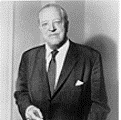
Mies van der Rohe (1886 – 1969)
Bauhaus Architect
Believing that “less is more,” Mies van der Rohe designed rational, minimalist skyscrapers that set the standard for modernist design.
The United States has a love-hate relationship with Mies van der Rohe. Some say that he stripped architecture of all humanity, creating cold, sterile and unlivable environments. Others praise his work, saying he created architecture in its most pure form.
Ludwig Mies van der Rohe began his career in his family stone-carving business in Germany. He never received any formal architectural training, but when he was a teenager he worked as a draftsman for several architects. Moving to Berlin, he found work in the offices of architect and furniture designer Bruno Paul and industrial architect Peter Behrens.
Early in his life, Mies van der Rohe began experimenting with steel frames and glass walls. He was director of the Bauhaus School of Design from 1930 until it disbanded in 1933. He moved to the United States in 1937 and for twenty years (1938-1958) he was Director of Architecture at the Illinois Institute of Technology.
Mies van der Rohe was not the first architect to practice simplicity in design, but he carried the ideals of rationalism and minimalism to new levels. His glass-walled Farnsworth House near Chicago stirred controversy and legal battles. His bronze and glass Seagram Building in New York City (designed in collaboration with Philip Johnson) is considered America’s first glass skyscraper. And, his philosophy that “less is more” became a guiding principle for architects in the mid-twentieth century. Skyscrapers around the world are modeled after designs by Mies van der Rohe.
Significant Buildings:
1929: Barcelona Pavilion
1950: Farnsworth House, Plano, Illinois
1951: Lake Shore Drive Apartments, Chicago
1956: Crown Hall, Chicago
1958: Seagram Building, New York (with Philip Johnson)